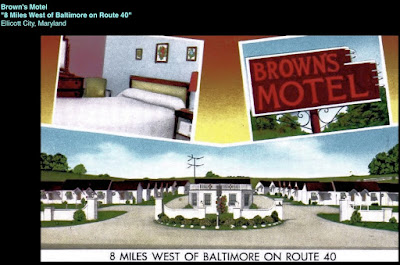Recent celebrations in Ellicott City have shone a light on the many stories to be told about life along the National Road. Route 40, better known to most of us, came along later. If you’re interested in local history with a bit of Americana thrown in, Route 40 could tell you a bit about a once successful part of automobile travel: the motel.
Depending on your age, you may or may not have stayed in one. The rise in the popularity of motels is aligned with the rise of greater long distance automobile travel in the US. Their fall came with the advent of superhighways. This article from the Smithsonian Magazine website is an engaging read:
“The Rise and Fall of the Great American Motel”, Andrew Wood, The Conversation
Until then, [the completion of the Interstate Highway Sytem] families took to whatever highways were available – cruising over rolling roads that followed the curves and undulations of the countryside. Whenever it suited them, they could easily pull off to visit small towns and landmarks.
At night, they found motor courts – no longer isolated cottages, but fully integrated buildings under a single roof – lit by neon and designed with flair. They would soon be referred to as “motels,” a name coined by the owner of the Milestone Mo-Tel (an abbreviation of “motor hotel”) in San Luis Obispo, California.
Many of the old motels that sprang up along Route 40 are gone now. Keeping track of them is the work of hobbyists and amateur historians. One Ellicott City motel has been in the news lately: Brown’s Motel.
Postcard Image from Kilduff’s Maryland Motels
Plans on the table for the motel site are for age-restricted senior apartments. The developer, Don Reuwer, is pursuing certain waivers for the project.
What caught my attention was the online mockery provoked by Howard County Council member Liz Walsh’s recent post:
Historic Brown's Motel is the feature of this week’s #WaiverWednesday. On 2.6 or so acres off Route 40W and surrounded otherwise by Patapsco Valley State Park, Brown's Motel has been there since the ‘50s.
Apparently some folks think calling Brown’s Motel “historic” is a laughable act.
To be clear, Brown’s is known locally in the category of “infamous.” Any basic Google search will clue you in. And here’s a lovely description from a website entitled “Frank Brusca’s Route 40.net”
Nestled high on the banks of the Patapsco River, this quiet little hostelry is one of Baltimore's most famous no-tell motels. Couples on the west side of Baltimore seeking a discreet location for a low rent rendezvous looked no farther than Brown's. For years people used to joke about how someone should start a lunch time shuttle service between the Social Security Administration offices in Woodlawn and Brown's Motel. Oh, the stories that could be told if the walls could only speak!
Today, Brown's still caters to the no-tell clientele as well as those seeking an affordable escape from chain motels. Of special note are the motel's exotic travel themed rooms. Those rooms include Parisian, Chinese, tropical, Cape Cod, African, Las Vegas and Indian motifs.
Brown’s Motel’s most recent attempt at engaging the public through social media seems to have been in 2016 when they created a Facebook page. That’s where I found these photos.
It’s interesting to compare the illustration from the postcard (created in its heyday) with the photo they shared in 2016.
It’s rather sad, actually.
Now, you may look at this property and say, “good riddance!” and be genuinely enthusiastic about a new use for this land. You may care deeply about the creation of new rental housing in Howard County - - we have a terrible deficit. It absolutely should be a priority.
But as infamous as it may be now, Brown’s Motel is a product of certain part of America’s history that was brief and ephemeral. This does not mean that every motel should be preserved as a sacred site. But it does mean that this time period and the societal and commercial forces at work are worth learning about, even if we learn things that don’t fit our own expectations.
Clearly Brown’s Motel is not a candidate for being named a National Historic Site. I don’t think there’s any debate on that. Is it a part of our history that has almost completely disappeared? Yes. Might it evoke a nostalgia for those small mom-and-pop businesses that welcomed weary travelers in days gone by? Sure.
Should we laugh at people who express that opinion?
I’m not sure I see the point in that.





No comments:
Post a Comment
Note: Only a member of this blog may post a comment.